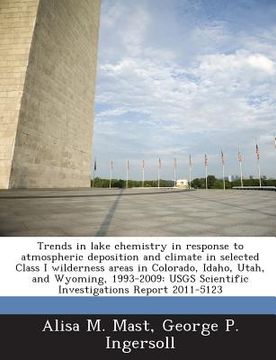Share
Trends in Lake Chemistry in Response to Atmospheric Deposition and Climate in Selected Class I Wilderness Areas in Colorado, Idaho, Utah, and Wyoming, (in English)
Alisa M. Mast
(Author)
·
George P. Ingersoll
(Author)
·
Bibliogov
· Paperback
Trends in Lake Chemistry in Response to Atmospheric Deposition and Climate in Selected Class I Wilderness Areas in Colorado, Idaho, Utah, and Wyoming, (in English) - Mast, Alisa M. ; Ingersoll, George P.
$ 14.95
$ 17.75
You save: $ 2.80
Choose the list to add your product or create one New List
✓ Product added successfully to the Wishlist.
Go to My WishlistsIt will be shipped from our warehouse between
Friday, July 05 and
Monday, July 08.
You will receive it anywhere in United States between 1 and 3 business days after shipment.
Synopsis "Trends in Lake Chemistry in Response to Atmospheric Deposition and Climate in Selected Class I Wilderness Areas in Colorado, Idaho, Utah, and Wyoming, (in English)"
In 2010, the U.S. Geological Survey, in cooperation with the U.S. Department of Agriculture Forest Service, Air Resource Management, began a study to evaluate long-term trends in lake-water chemistry for 64 high-elevation lakes in selected Class I wilderness areas in Colorado, Idaho, Utah, and Wyoming during 1993 to 2009. The purpose of this report is to describe trends in the chemical composition of these high-elevation lakes. Trends in emissions, atmospheric deposition, and climate variables (air temperature and precipitation amount) are evaluated over a similar period of record to determine likely drivers of changing lake chemistry. Sulfate concentrations in precipitation decreased over the past two decades at high-elevation monitoring stations in the Rocky Mountain region. The trend in deposition chemistry is consistent with regional declines in sulfur dioxide emissions resulting from installation of emission controls at large stationary sources. Trends in nitrogen deposition were not as widespread as those for sulfate. About one-half of monitoring stations showed increases in ammonium concentrations, but few showed significant changes in nitrate concentrations. Trends in nitrogen deposition appear to be inconsistent with available emission inventories, which indicate modest declines in nitrogen emissions in the Rocky Mountain region since the mid-1990s. This discrepancy may reflect uncertainties in emission inventories or changes in atmospheric transformations of nitrogen species that may be affecting deposition processes. Analysis of long-term climate records indicates that average annual mean air temperature minimums have increased from 0.57 to 0.75 C per decade in mountain areas of the region with warming trends being more pronounced in Colorado. Trends in annual precipitation were not evident over the period 1990 to 2006, although wetter than average years during 1995 to 1997 and drier years during 2001 to 2004 caused a notable decline in precipitation in the middle part of the record."

